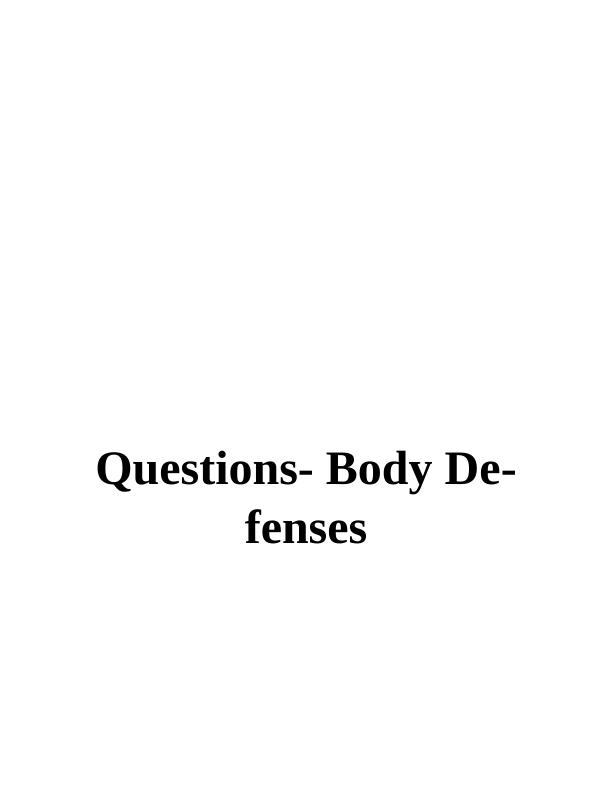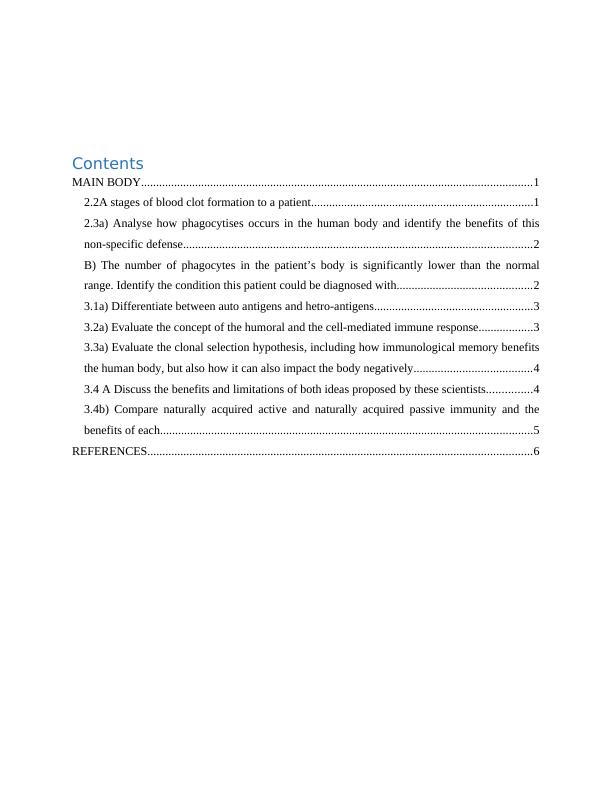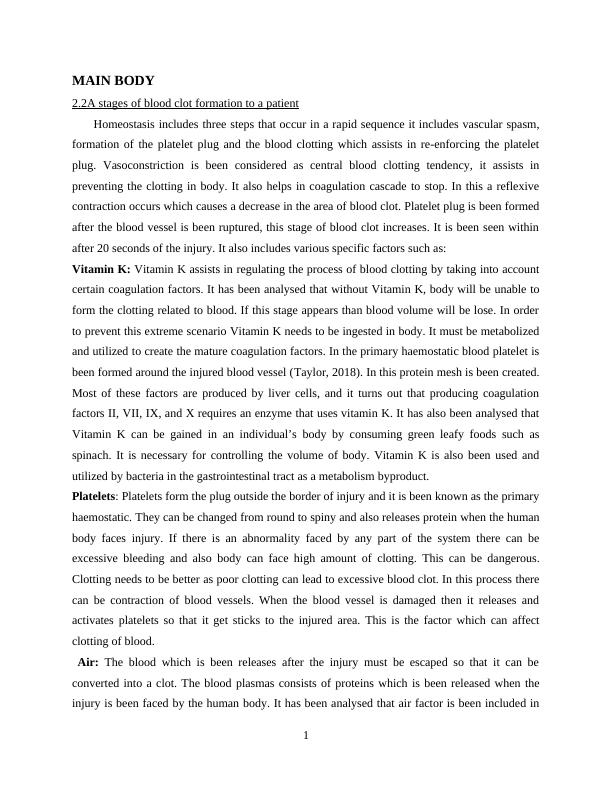Body Defenses: Stages of Blood Clot Formation, Phagocytosis, Autoantigens and Heteroantigens, Humoral and Cell-Mediated Immune Response, Clonal Selection Hypothesis, Active and Passive Immunity
Added on 2023-01-03
8 Pages2530 Words92 Views
Questions- Body De-
fenses
fenses

Contents
MAIN BODY..................................................................................................................................1
2.2A stages of blood clot formation to a patient..........................................................................1
2.3a) Analyse how phagocytises occurs in the human body and identify the benefits of this
non-specific defense....................................................................................................................2
B) The number of phagocytes in the patient’s body is significantly lower than the normal
range. Identify the condition this patient could be diagnosed with.............................................2
3.1a) Differentiate between auto antigens and hetro-antigens.....................................................3
3.2a) Evaluate the concept of the humoral and the cell-mediated immune response..................3
3.3a) Evaluate the clonal selection hypothesis, including how immunological memory benefits
the human body, but also how it can also impact the body negatively.......................................4
3.4 A Discuss the benefits and limitations of both ideas proposed by these scientists...............4
3.4b) Compare naturally acquired active and naturally acquired passive immunity and the
benefits of each............................................................................................................................5
REFERENCES................................................................................................................................6
MAIN BODY..................................................................................................................................1
2.2A stages of blood clot formation to a patient..........................................................................1
2.3a) Analyse how phagocytises occurs in the human body and identify the benefits of this
non-specific defense....................................................................................................................2
B) The number of phagocytes in the patient’s body is significantly lower than the normal
range. Identify the condition this patient could be diagnosed with.............................................2
3.1a) Differentiate between auto antigens and hetro-antigens.....................................................3
3.2a) Evaluate the concept of the humoral and the cell-mediated immune response..................3
3.3a) Evaluate the clonal selection hypothesis, including how immunological memory benefits
the human body, but also how it can also impact the body negatively.......................................4
3.4 A Discuss the benefits and limitations of both ideas proposed by these scientists...............4
3.4b) Compare naturally acquired active and naturally acquired passive immunity and the
benefits of each............................................................................................................................5
REFERENCES................................................................................................................................6

MAIN BODY
2.2A stages of blood clot formation to a patient
Homeostasis includes three steps that occur in a rapid sequence it includes vascular spasm,
formation of the platelet plug and the blood clotting which assists in re-enforcing the platelet
plug. Vasoconstriction is been considered as central blood clotting tendency, it assists in
preventing the clotting in body. It also helps in coagulation cascade to stop. In this a reflexive
contraction occurs which causes a decrease in the area of blood clot. Platelet plug is been formed
after the blood vessel is been ruptured, this stage of blood clot increases. It is been seen within
after 20 seconds of the injury. It also includes various specific factors such as:
Vitamin K: Vitamin K assists in regulating the process of blood clotting by taking into account
certain coagulation factors. It has been analysed that without Vitamin K, body will be unable to
form the clotting related to blood. If this stage appears than blood volume will be lose. In order
to prevent this extreme scenario Vitamin K needs to be ingested in body. It must be metabolized
and utilized to create the mature coagulation factors. In the primary haemostatic blood platelet is
been formed around the injured blood vessel (Taylor, 2018). In this protein mesh is been created.
Most of these factors are produced by liver cells, and it turns out that producing coagulation
factors II, VII, IX, and X requires an enzyme that uses vitamin K. It has also been analysed that
Vitamin K can be gained in an individual’s body by consuming green leafy foods such as
spinach. It is necessary for controlling the volume of body. Vitamin K is also been used and
utilized by bacteria in the gastrointestinal tract as a metabolism byproduct.
Platelets: Platelets form the plug outside the border of injury and it is been known as the primary
haemostatic. They can be changed from round to spiny and also releases protein when the human
body faces injury. If there is an abnormality faced by any part of the system there can be
excessive bleeding and also body can face high amount of clotting. This can be dangerous.
Clotting needs to be better as poor clotting can lead to excessive blood clot. In this process there
can be contraction of blood vessels. When the blood vessel is damaged then it releases and
activates platelets so that it get sticks to the injured area. This is the factor which can affect
clotting of blood.
Air: The blood which is been releases after the injury must be escaped so that it can be
converted into a clot. The blood plasmas consists of proteins which is been released when the
injury is been faced by the human body. It has been analysed that air factor is been included in
1
2.2A stages of blood clot formation to a patient
Homeostasis includes three steps that occur in a rapid sequence it includes vascular spasm,
formation of the platelet plug and the blood clotting which assists in re-enforcing the platelet
plug. Vasoconstriction is been considered as central blood clotting tendency, it assists in
preventing the clotting in body. It also helps in coagulation cascade to stop. In this a reflexive
contraction occurs which causes a decrease in the area of blood clot. Platelet plug is been formed
after the blood vessel is been ruptured, this stage of blood clot increases. It is been seen within
after 20 seconds of the injury. It also includes various specific factors such as:
Vitamin K: Vitamin K assists in regulating the process of blood clotting by taking into account
certain coagulation factors. It has been analysed that without Vitamin K, body will be unable to
form the clotting related to blood. If this stage appears than blood volume will be lose. In order
to prevent this extreme scenario Vitamin K needs to be ingested in body. It must be metabolized
and utilized to create the mature coagulation factors. In the primary haemostatic blood platelet is
been formed around the injured blood vessel (Taylor, 2018). In this protein mesh is been created.
Most of these factors are produced by liver cells, and it turns out that producing coagulation
factors II, VII, IX, and X requires an enzyme that uses vitamin K. It has also been analysed that
Vitamin K can be gained in an individual’s body by consuming green leafy foods such as
spinach. It is necessary for controlling the volume of body. Vitamin K is also been used and
utilized by bacteria in the gastrointestinal tract as a metabolism byproduct.
Platelets: Platelets form the plug outside the border of injury and it is been known as the primary
haemostatic. They can be changed from round to spiny and also releases protein when the human
body faces injury. If there is an abnormality faced by any part of the system there can be
excessive bleeding and also body can face high amount of clotting. This can be dangerous.
Clotting needs to be better as poor clotting can lead to excessive blood clot. In this process there
can be contraction of blood vessels. When the blood vessel is damaged then it releases and
activates platelets so that it get sticks to the injured area. This is the factor which can affect
clotting of blood.
Air: The blood which is been releases after the injury must be escaped so that it can be
converted into a clot. The blood plasmas consists of proteins which is been released when the
injury is been faced by the human body. It has been analysed that air factor is been included in
1

End of preview
Want to access all the pages? Upload your documents or become a member.
Related Documents
Haemostasis Mechanism: Steps and Factors Involvedlg...
|5
|910
|418
A Study on Pathophysiology | Reportlg...
|4
|994
|14
Bleeding, Anticoagulation and the Cascade Pathwaylg...
|20
|6127
|409
Nursing Care Plan Assignment(NCP)lg...
|8
|2171
|1126
Palliative Care for Bleeding and Bruising in Leukemia Patientslg...
|7
|1369
|136
Effect of Type 1 Diabetes on Endocrine, Cardiovascular, and Metabolic Systemslg...
|9
|2838
|311
